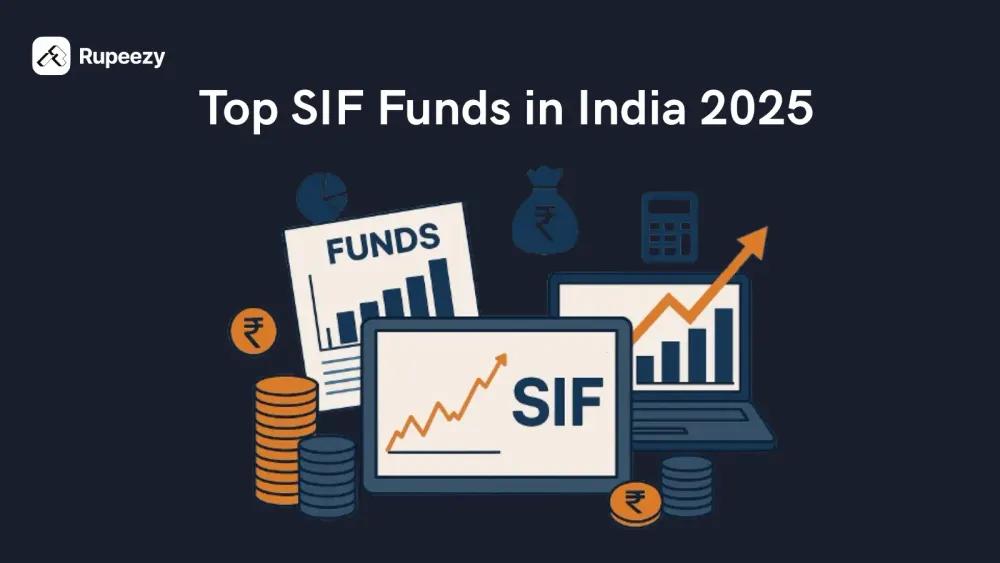Top SIF Funds in India 2025


00:00 / 00:00
2025 is shaping up to be a transformative year for the Indian investment market. Following new SEBI guidelines, Specialized Investment Funds (SIFs) are gaining popularity as they combine the convenience of traditional mutual funds with advanced long-short and hybrid strategies like PMS. In this blog, we'll explore the Top SIF Funds in India 2025, how they work, which investors are best suited for, and their role in a portfolio, helping investors make informed decisions.
What are SIFs?
Specialized Investment Funds (SIFs) are a modern investment structure formally implemented by SEBI in 2025. They were developed for investors who seek stable and risk-balanced returns through more advanced strategies, moving beyond traditional mutual funds. Their unique advantage is that they offer the convenience and comfort of mutual funds, but allow for more flexible and progressive investment styles, such as PMS and AIFs.
Top SIF Funds in India 2025
Name of the Fund | AMC | Summary |
SBI Mutual Fund | Launched under the new SIF framework, the fund has a hybrid/long-short strategy operating across high-low market cycles. | |
Quant Mutual Fund | Quant-based long-short strategy with a focus on mid- and small-cap stocks, with limited short exposure. | |
Quant Mutual Fund | A hybrid long-short strategy offered by Quant MF, with active exposure to both equity and debt. | |
Edelweiss Mutual Fund (Altiva SIF Platform) | Hybrid long-short strategy combining arbitrage, fixed-income, special situations, and derivatives. | |
Edelweiss Altiva SIF – Multi Asset Hybrid | Edelweiss Mutual Fund | Altiva targets a multi-asset hybrid strategy within the SIF platform – actively investing across different asset classes. |
1. SBI Magnum SIF :
SBI Magnum SIF's "Hybrid Long Short Fund" model is specifically designed for investors with a clear vision to invest in both equity and debt, while also having the ability to take some short exposure. The fund aims to deliver superior risk-adjusted returns across various market cycles. It invests in equities, fixed-income, derivatives, and REITs/InvITs. The minimum investment amount is approximately Rs.10 lakh.
Aspect | Description |
Name of the Fund | SBI Magnum SIF – Hybrid Long Short Fund |
Strategy | Equity + Debt + Derivatives with Short Position Option |
Minimum Investment | Around Rs.10 lakh |
Main goal | Better risk-adjusted returns across different market cycles |
Taxation Approach | Equity category tax rules apply (when equity exposure >65%) |
2. Quant Equity Long Short Fund :
Quant Mutual Fund has launched this SIF to target the segment where there are opportunities in equities (mid-/small-cap) outside the top 100 companies. The fund's strategy is to build a long position in equities along with a limited short position to generate better risk-adjusted returns across market cycles. The minimum investment amount is around Rs.10 lakh. This fund is unique because it offers the opportunity to use alternative instruments such as derivatives and short positions within the SIF framework, which was extremely limited in traditional mutual funds.
Aspect | Description |
Name of the Fund | Quant Equity Long Short Fund |
Strategy | Balancing risk through long, limited short derivatives in mid/small-cap equities |
Minimum Investment | Around Rs.10 lakh |
Main goal | Identifying equity opportunities outside the top 100 companies and achieving better risk-adjusted returns through long-short portfolios |
Taxation Approach | Under the SIF framework potential for mutual-fund-like taxation benefits |
3. Quant Hybrid Long-Short Fund :
Quant Mutual Fund launched this SIF with a hybrid long-short strategy, investing in both equity and debt instruments while simultaneously managing risk through short derivative exposure. It was launched through an NFO on September 25, 2025. The minimum application amount was approximately Rs.10 lakh. The fund aims to balance capital appreciation and income generation, while minimizing risk through short positions.
Aspect | Description |
Name of the Fund | Quant Hybrid Long-Short Fund |
Strategy | 25 September 2025 (NFO) |
Minimum Investment | Around Rs.10 lakh |
Main goal | Equity (25-75%), Debt (25-75%), Short Derivatives (0-25%) |
Taxation Approach | Generating capital appreciation + income, delivering risk-balanced returns |
4. Altiva Hybrid Long-Short Fund :
This hybrid long-short fund from Edelweiss Mutual Fund's Altiva SIF series is based on a mix of equity, fixed-income, short position, and derivative strategies. The minimum investment is approximately Rs.10 lakh. The fund's objective is to provide stable and balanced returns while protecting against various market cycles, serving as an all-weather investment option.
Aspect | Description |
Name of the Fund | Altiva Hybrid Long-Short Fund |
Strategy | Edelweiss Mutual Fund |
Minimum Investment | Around Rs.10 lakh (normal investor) |
Main goal | Combination of equity + fixed-income + derivatives/short positions |
Taxation Approach | Balanced growth while managing risk in diverse market conditions |
5. Edelweiss Altiva SIF – Multi Asset Hybrid Fund :
This multi-asset hybrid fund, part of Edelweiss' Altiva SIF platform, actively invests across multiple asset classes: equity, fixed-income, arbitrage, and derivatives. Its objective is to deliver stable and balanced returns while controlling risk, regardless of market conditions. The minimum investment amount is approximately Rs.10 lakh.
Aspect | Description |
Name of the Fund | Edelweiss Altiva SIF – Multi Asset Hybrid Fund |
Strategy | Launching in Q1 2025 under the Altiva SIF platform |
Minimum Investment | Equity, debt, arbitrage, derivatives + multi-asset mix |
Main goal | Around Rs.10 lakh |
Taxation Approach | Balanced growth while managing risk across various market cycles |
How do SIFs differ from traditional mutual funds?
Mutual funds typically follow a long-only investment style, while SIFs can utilize advanced strategies such as both long and short positions, hedging, sector rotation, multi-asset investments, and derivatives. Therefore, SIFs aim to stabilize returns and control losses not only in bullish markets but also in bearish and volatile markets. This distinction makes SIFs a more intelligent and active investment solution than mutual funds.
What type of investors are SIFs suitable for?
SIFs are ideal for investors who already have a well-established and large investment portfolio and value downside protection along with more sensible gains. They are suitable for those who want to maintain portfolio stability even during market fluctuations. However, they are not a good option for beginner investors and those with limited capital, as they typically require a minimum investment of around Rs.10 lakh and an understanding of relatively complex investment strategies.
Types of SIF Strategies Available in 2025
Equity Long Short SIFs :
This category includes strategies where the majority of the fund is invested in listed equities, but the manager is permitted to take limited short positions and use derivatives. For example, an Equity Long–Short Fund invests a minimum of 80% in equities and can take up to 25% of uncovered short exposure. This strategy is particularly effective in markets where there is no clear direction (sideways market) or bearish risk; short positions can protect against potential downside risks.
Hybrid / Multi-Asset Long–Short SIFs :
This category invests in both equities and debt, and sometimes uses REITs/InvITs, commodities, and derivatives. SEBI guidelines require this strategy to have a minimum of 25% equity and 25% debt exposure, and allow up to 25% short exposure. These types of funds are particularly useful when the market is directionless or when investors want to diversify their portfolio and minimize risk.
Sector-Rotation / Thematic SIFs :
Funds in this category focus on a specific number of sectors (for example, a maximum of four) and strategically rotate them, which sectors are currently offering opportunities and which sectors are at risk. Short positions can also be taken to hedge during sector shifts. This strategy operates actively according to market cycles—when a sector's trend is changing, or an investor sees opportunities in a specific sector.
Quant-Driven / SMID-Focused SIFs :
This strategy is data- and model-driven, where fund managers use automated/quant models to find opportunities in small- and mid-cap companies (SMIDs), or analysis-less research companies. For example, such SIFs may use an "Equity Ex-Top 100 Long-Short" or mid/small-cap allied long-short model. These strategies are for aggressive, risk-averse investors as they may experience higher volatility but also offer higher return potential.
What to consider before investing in SIF?
Clarify Your Objective First :
Before choosing a SIF, it's important to determine why you're investing. Do you want portfolio stability, protection from market downturns, or can you accept higher risk for additional returns? Only after defining your objective can you select a SIF with the appropriate strategy.
Check the AMC and Fund Manager's Experience :
SIFs are a new structure, so it's important to understand the fund management team's prior experience handling long-short, derivatives, or multi-asset strategies. It's best to prioritize AMCs that have proven consistent performance across complex strategies.
Develop a Deep Understanding of Strategy and Risk :
Each SIF's strategy is different; some focus on equity long-short, some on multi-asset, and some on sector-rotation or quant models. Before choosing a fund, it's important to understand its returns, the conditions under which it performs well, and when performance may slow.
Minimum Investment, Lock-in, and Taxation are Important to Understand :
SIFs generally require a minimum investment of around Rs.10 lakh, and many schemes may also have partial lock-in or limited withdrawals. Taxation also depends on the fund's equity exposure, so it's important to fully understand these terms before investing.
Determine Portfolio Investment Ratio :
SIFs are typically included as part of a portfolio, rather than as a whole, to maintain diversification and balance risk. Optimizing for better returns isn't a good idea. Proper allocation helps maximize the benefits of an SIF.
Conclusion
In the 2025 investment environment, SIFs have emerged as an alternative, offering a balanced path between traditional mutual funds and advanced PMS. Their objective is not only to generate higher returns but also to maintain portfolio stability and security in uncertain market conditions. However, their complex structure and high minimum investment requirements make them not suitable for every investor. A SIF chosen with proper research, risk understanding, and clear financial goals can strengthen a portfolio and provide a better investment experience in the long run.
FAQs
Q1. What is a SIF in investing?
SIF stands for Specialized Investment Fund, which allows investing with long-short and advanced strategies.
Q2. Is a SIF good for beginners?
No, SIFs are not suitable for beginner investors because the strategies are complex and the risks are high.
Q3. What is the minimum investment required?
Most SIFs require a minimum investment of around Rs.10 lakh.
Q4. Does a SIF guarantee returns?
No, SIFs are market-based and do not provide guaranteed returns.
Q5. Who should invest in a SIF?
Investors with a large portfolio who want risk-controlled returns in volatile markets.
The content on this blog is for educational purposes only and should not be considered investment advice. While we strive for accuracy, some information may contain errors or delays in updates.
Mentions of stocks or investment products are solely for informational purposes and do not constitute recommendations. Investors should conduct their own research before making any decisions.
Investing in financial markets are subject to market risks, and past performance does not guarantee future results. It is advisable to consult a qualified financial professional, review official documents, and verify information independently before making investment decisions.

All Category









